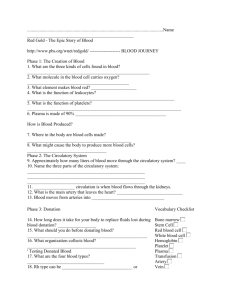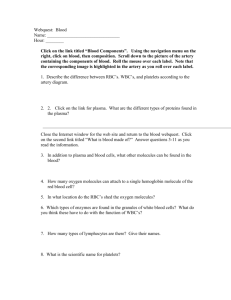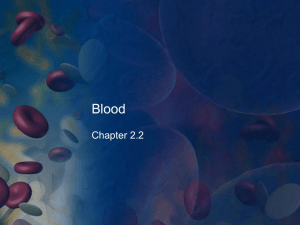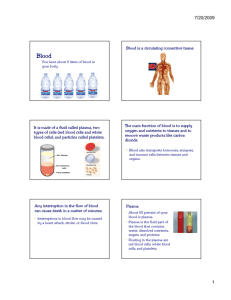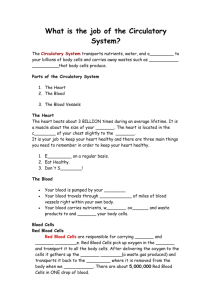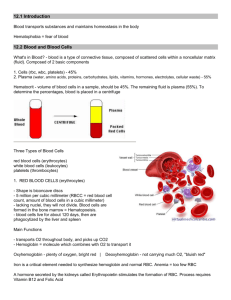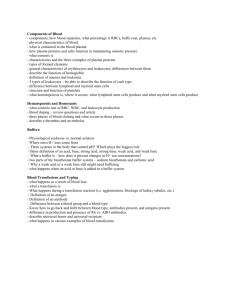Webquest: Blood Name: Period: ______ Click on the link titled
advertisement
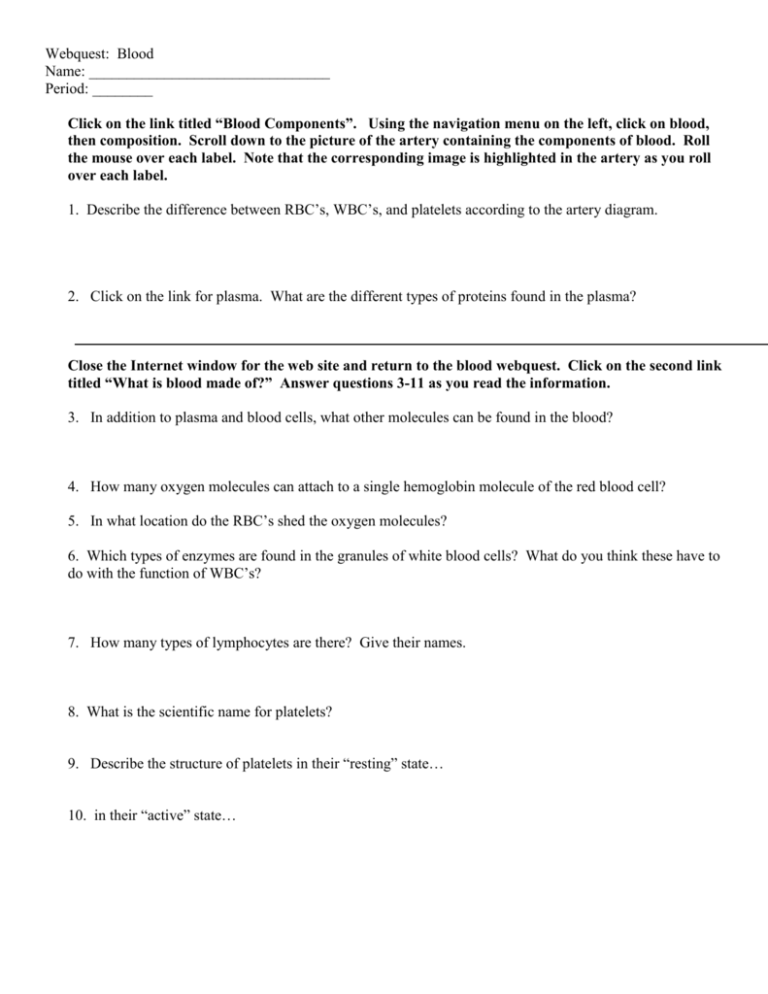
Webquest: Blood Name: ________________________________ Period: ________ Click on the link titled “Blood Components”. Using the navigation menu on the left, click on blood, then composition. Scroll down to the picture of the artery containing the components of blood. Roll the mouse over each label. Note that the corresponding image is highlighted in the artery as you roll over each label. 1. Describe the difference between RBC’s, WBC’s, and platelets according to the artery diagram. 2. Click on the link for plasma. What are the different types of proteins found in the plasma? Close the Internet window for the web site and return to the blood webquest. Click on the second link titled “What is blood made of?” Answer questions 3-11 as you read the information. 3. In addition to plasma and blood cells, what other molecules can be found in the blood? 4. How many oxygen molecules can attach to a single hemoglobin molecule of the red blood cell? 5. In what location do the RBC’s shed the oxygen molecules? 6. Which types of enzymes are found in the granules of white blood cells? What do you think these have to do with the function of WBC’s? 7. How many types of lymphocytes are there? Give their names. 8. What is the scientific name for platelets? 9. Describe the structure of platelets in their “resting” state… 10. in their “active” state… 11. Plasma is 90% water and 10% “other”. Circle all of the following that make up the 10% of “other”. (circle all that apply) leukocytes immunoglobulins vitamins cholesterol platelets glucose thrombocytes eosinophils monocytes erythrocytes hormones water Red Gold - The Epic Story of Blood http://www.pbs.org/wnet/redgold/ -------------------- BLOOD JOURNEY Phase 1: The Creation of Blood 1. What are the three kinds of cells found in blood? ______________________________________________________ 2. What molecule in the blood cell carries oxygen? _____________________________________________ 3. What element makes blood red? ____________________ 4. What is the function of leukocytes? _________________________________________________________________ 5. What is the function of platelets? ____________________________________________________________________ 6. Plasma is made of 90% ________________________________________ How is Blood Produced? 7. Where in the body are blood cells made? ______________________________________________ 8. What might cause the body to produce more blood cells? ___________________________________ Phase 2: The Circulatory System 9. Approximately how many liters of blood move through the circulatory system? ____ 10. Name the three parts of the circulatory system: ____________________________________________________ ____________________________________________________ ____________________________________________________ 11. __________________ circulation is when blood flows through the kidneys. 12. What is the main artery that leaves the heart? _____________________________ 13. Blood moves from arteries into ________________________________ Phase 3: Donation Vocabulary Checklist 14. How long does it take for your body to replace fluids lost during blood donation? _________________ 15. What should you do before donating blood? _____________________________________________________ 16. What organization collects blood? ________________________________________________ ' Testing Donated Blood 17. What are the four blood types? __________________________________ 18. Rh type can be _______________________________ or ________________________________ 19. Name two diseases you would be tested for before donating blood: ___________________________________ Bone marrow Stem Cell Red blood cell White blood cell Hemoglobin Platelet Plasma Transfusion Artery Vein Capillary Aorta Leukemia Hepatitis Phase 4: Blood Banks 20. Blood donated is split into three components. What are they? _______________________________________ 21. What type of patients might use the platelets? ________________________________________ 22. What type of patients might use the plasma? ___________________________________________ Phase 5: The Transfusion 23. Which blood type can receive blood from all groups? ___________________________ 24. What are the two most common blood types in the U.S.? ____________________________ Test Your Blood IQ (take the quiz to get these answers) 1. How long do red blood cells stay in the body? _____________________ 2. Blood circulates through the body in what order? ___________________________________________ 3. How much blood is there in the average adult human body? ___________________ 4. You should not donate blood more often than about: _________________________________ 5. In the blood disease called leukemia, the body produces _________________________________ 6. If you have type O blood, you can safely receive transfusions of _________________________ 7. Under normal circumstances, the blood transfers a lot of excess heat from: _________________________ 8. What makes the pulmonary arteries unique among arteries? _______________________________________ 9. Neutrophils and leukocytes are: ______________________________ 10. Which blood vessels have one-way valves? ____________________________ EXTENSION: Using what you know about blood and transfusions, design a poster to educate on blood donations and encourage people to donate. There are some examples on the site at Blood History ' The Impact of War ' Poster Gallery. You will use your computer and log on to your Glogster account to create your poster.
